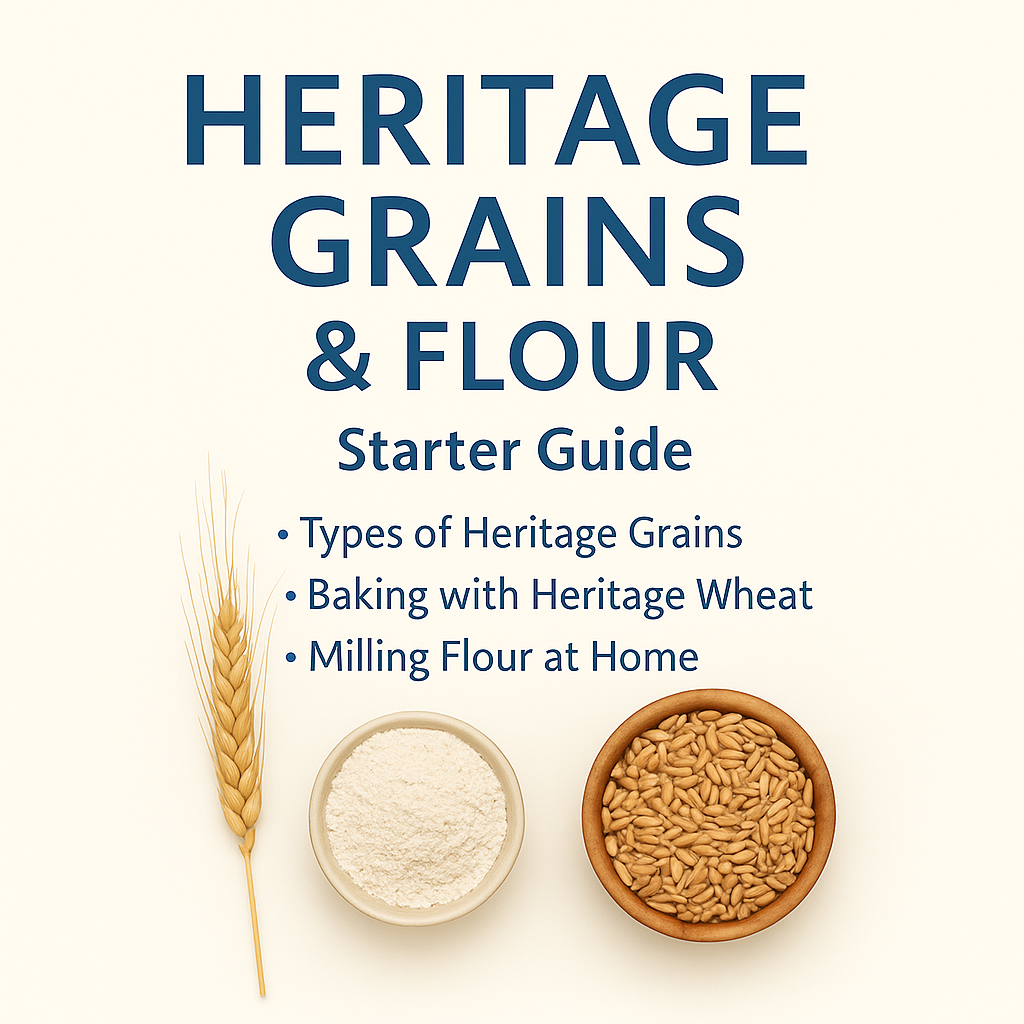Hard Red Wheat vs. Soft White Wheat: How to Choose the Right Flour for Your Baking
My first experiments with different wheat varieties were complete guesswork. I'd grab whatever wheat berries looked good at the store and wonder why my bread turned out dense one week and my muffins came out tough the next. That's when I learned that hard red wheat and soft white wheat behave completely differently in baking, and choosing the right one makes the difference between success and frustration.
Understanding these two wheat varieties will transform your fresh-milled baking results. Both deserve space in the home miller's pantry, but knowing which one to use when saves you from disappointing failures and helps you create consistently better baked goods.
Get The Guide
Ready to stop wondering what grain to buy or how to use it once you mill it? This guide covers heritage grain selection, storage basics, and beginner-friendly techniques for milling and baking with fresh flour. No more staring at wheat berries wondering what comes next, just clear steps and practical tips so you can actually taste the difference fresh-milled flour makes in your kitchen.
Disclosure
Some links on FiberMaiden are affiliate links. When you click and purchase, I may earn a small commission at no extra cost to you. I partner only with brands and tools I trust and use in my own kitchen, studio, and garden. Your support means a lot.
Hard Red Wheat: The Structure Builder
Hard red wheat contains higher protein content, typically 12-15%, which translates to stronger gluten formation. This makes it ideal for yeast-based breads, pizza dough, dinner rolls, and bagels where you need structure and rise. The gluten network traps gas from yeast fermentation, creating the chewy texture and good rise that makes bread satisfying.
The flavor profile is nuttier, bolder, and distinctly wheaty compared to modern refined flours. This is what bread used to taste like before industrial processing stripped away character in favor of shelf stability. Hard red wheat creates hearty, substantial baked goods that taste like real food rather than refined starch.
Soft White Wheat: The Tender Touch
Soft white wheat contains less protein, usually 9-11%, resulting in weaker gluten formation and more delicate textures. This makes it perfect for cakes, muffins, pancakes, cookies, and pie crusts where tenderness matters more than structure. The lower protein content creates the soft, fluffy textures that make pastries appealing.
The flavor is milder and slightly sweet, with a softer presence that doesn't overwhelm other ingredients. This wheat lets other flavors shine through while providing the nutritional benefits of whole grain flour without the assertive taste that some people find off-putting in delicate baked goods.
When to Use Which Wheat
The key is matching wheat type to your desired outcome. If you're making something that needs to rise and hold its shape, hard red wheat provides the protein structure necessary for success. If you're creating something meant to be tender and light, soft white wheat delivers the gentle texture you're seeking.
Hard red wheat excels in sourdough breads, hearty sandwich loaves, and anything where you want substantial chew and complex grain flavor. Soft white wheat shines in quick breads, tender muffins, and delicate pastries where harsh wheat flavors would compete with other ingredients.
Blending for Balance
Many experienced millers blend wheat varieties to balance flavor and texture. A mixture of hard red and soft white wheat can give you some structural strength with softer overall texture, creating versatile flour that works in multiple applications.
For beginners transitioning from store-bought flour, consider replacing only one-third of your regular flour with fresh-milled initially. This allows your recipes and taste preferences to adjust gradually without dramatically changing familiar results.
Get 3 Free Recipe Sheets
Ready for recipes that don't require a culinary degree to follow? Get seasonal recipe sheets designed for real kitchens and busy lives, the kind that work even when your kids are asking for snacks mid-prep.
Storage and Freshness Considerations
Both wheat varieties should be stored as whole berries until you're ready to use them, then milled fresh for maximum flavor and nutrition. Whole wheat berries keep for years when stored properly, but fresh-milled flour begins losing flavor and nutritional value within days.
Different wheat varieties may also behave differently depending on crop year, growing conditions, and storage time. Keep notes about how specific batches perform so you can adjust recipes accordingly.
Making the Choice
The best way to understand these wheat varieties is to mill and bake with both. Make the same recipe with hard red wheat flour and soft white wheat flour to experience the differences firsthand. Your taste buds and the texture of finished products will teach you more than any description.
Once you understand how each wheat behaves in your specific recipes and baking conditions, you can make informed choices that consistently improve your results. The goal isn't to find one perfect wheat, but to understand which wheat serves each baking purpose best.
Frequently Asked Questions
Grain & Flour Quick Guide
Simple chart and tips for choosing grains, flour types, and blends for fresh milled and store flour.
Best for bread: Hard red or hard white
Best for tender bakes: Soft white
Mild flavor: Hard white • Robust flavor: Hard red
Flatbreads and tortillas: Hard white or a red and white blend
Grain comparison
| Grain | Typical protein | Best for | Flavor notes | Notes |
|---|---|---|---|---|
| Hard Red Wheat | ~12–15% | Yeasted bread, sourdough, pizza, bagels | Nutty, fuller flavor, tan crumb | Strong gluten for rise. Great for 100% whole grain loaves. |
| Hard White Wheat | ~11–14% | Sandwich bread, rolls, tortillas | Mild, slightly sweet, lighter color | Kid friendly flavor with good rise and soft crumb. |
| Soft White Wheat | ~8–10% | Cookies, cakes, muffins, crackers | Delicate, pale crumb | Low gluten. Blend with hard wheat for tall loaves. |
| Einkorn | ~9–12% | Pastry, cookies, quick breads, flatbreads | Buttery, sweet, golden | Weaker gluten. Mix gently. Often lower hydration than modern wheat. |
| Spelt | ~11–15% | Bread blends, pancakes, muffins | Sweet, slightly nutty | Extensible gluten. Handle gently to avoid spread in loaves. |
| Rye | ~7–10% | Rye breads, crackers, blends | Earthy, tangy | Little gluten. Great at 10–40% in blends for flavor and keeping. |
Fresh milled flour tips
- Hydration: plan a bit more water than store flour. Add gradually.
- Autolyse: rest flour and water 20–30 minutes before kneading to soften bran.
- Mixing: shorter knead, more folds. Whole grain tightens if overworked.
- Proofing: whole grain ferments faster. Watch the dough, not the clock.
- Sifting option: sift coarse bran, soak it in a little water, then fold in.
Simple substitutions
- Red and white (hard): swap 1:1. Flavor and color shift slightly.
- Soft white in bread: blend 25–40% soft with hard wheat. Reduce water slightly.
- No bread flour on hand: use hard white or hard red and add a touch more water.
- Einkorn swap: use by itself for cookies and quick bakes or blend 25–50% in bread.
Quick reference
| Use | Best choice | Backup blend |
|---|---|---|
| Everyday sandwich bread | Hard white | 50 50 hard red and hard white |
| Rustic sourdough or pizza | Hard red | 70% hard red + 30% hard white |
| Tender cookies and cakes | Soft white | Soft white + 10–20% hard white |
| Tortillas and flatbreads | Hard white | 60% hard white + 40% soft white |
© FiberMaiden • www.fibermaiden.com









